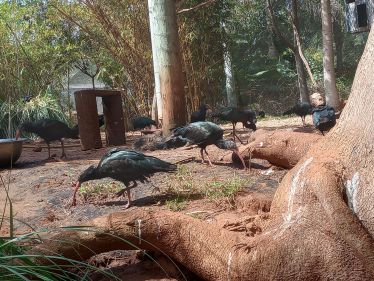- Ostrich (Struthioniformes)
- Rhea (Rheiformes)
- Gamefowl (Galliformes)
- Waterfowl (Anseriformes)
- Flamingo (Phoenicopteriformes)
- Doves (Columbiformes)
- Turacos (Musophagiformes)
- Cranes (Gruiformes)
- Shorebirds (Charadriiformes)
- Penguin (Sphenisciformes)
- Stork (Ciconiiformes)
- Gannet (Suliformes)
- Pelican (Pelecaniformes)
- Hawk (Accipitriformes)
- Owl (Strigiformes)
- Hornbills (Bucerotiformes)
- Kingfisher (Coraciiformes)
- Woodpecker (Piciformes)
- Seriema (Cariamiformes)
- Falcon (Falconiformes)
- Parrot (Psittaciformes)
- Perching birds (Passeriformes)
Northern bald ibis (Geronticus eremita)

Picture taken in Rabat, Morocco
The northern bald ibis, hermit ibis, or waldrapp (Geronticus eremita) is a migratory bird found in barren, semi-desert or rocky habitats, often close to running water. This 70–80 cm (28–31 in) glossy black ibis, which, unlike many members of the ibis family, is non-wading, has an unfeathered red face and head, and a long, curved red bill. It breeds colonially on coastal or mountain cliff ledges, where it typically lays two to three eggs in a stick nest, and feeds on lizards, insects, and other small animals. The northern bald ibis was once widespread across the Middle East, northern Africa, southern and central Europe, with a fossil record dating back at least 1.8 million years. It disappeared from Europe over 300 years ago, although reintroduction programs in the region are underway. In 2019 there were about 700 wild birds remaining in southern Morocco, and fewer than 10 in Syria, where it was rediscovered in 2002 but where their number declined in the following years, maybe to zero. To combat these low numbers, reintroduction programs have been instituted internationally in recent times, with a semi-wild breeding colony in Turkey which counted almost 250 birds in 2018 as well as sites in Austria, Italy, Spain, and northern Morocco. These programs and the natural growth in Morocco from about 200 birds in the 1990s helped to downlist the northern bald ibis from Critically Endangered to Endangered on the IUCN Red List in 2018. There are about 2000 northern bald ibises living in captivity. The long-term decline in Europe has been linked to hunting and eating them, especially the fledlings. Together with the slow reproduction of the ibises this may lead to local extinction.
In Aquariums and Zoos: very common in Europe
In Aquariums and Zoos: very common in Europe
woaqzo@yahoo.com